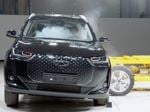It will provide a small boost to the 258 retailers in the network, many of whom have been left with cashflow problems because of the outstanding bonuses and payments that MG Rover was due to pay when it went into administration last month. According to the RMI, the network is owed more than £25m.
“What has been confirmed is deferment on immediate and current VAT payments up to the limit of the MG Rover bad debt they are owed. This at least stops them having to pay cash out on debts they haven’t recovered and gives them some breathing space while they reorganise their business,” says Nick Paul, chairman of the MG Rover Task Force.
HM Revenue and Customs has also offered a similar deal to component suppliers affected by the closure of Longbridge, MG Rover’s car assembly plant.
Richard Cort, chairman of the MG Rover Dealer Association, praised the action of the Government. “The bureaucrats are delivering results. Sir Digby Jones and Nick Paul have now ensured dealers rank on a par with suppliers in terms of receiving aid. This is great news,” he says.
Main worries
Cort hopes an upcoming meeting with Capital Bank will also prove fruitful. He sees the main issues concerning MG Rover dealers as: what price they will be made to pay for any cars potentially en-route to them from Rover; warranties; and the flow of information. Last week, administrators from PricewaterhouseCoopers announced 363 redundancies at Powertrain, the engine and transmission division of Phoenix Venture Holdings, although efforts to find a buyer will continue.
A further 58 jobs were lost at MG Rover Group and MG Sport and Racing. Those followed the closure of two more Phoenix Venture Motors dealerships in Rednal and Bromsgrove, in addition to the three shut a week earlier.
PwC plans to use the six remaining dealerships in Preston, Chorley, Coventry, Hatfield, Romford and Kidderminster, to sell off group stock at a discount while a buyer is sought. MG Rover, which owned the leases to the retail sites, has pledged any revenue raised from the sale to the trust fund to be put towards employee remuneration.
Administrators have also been called in to Edwards Cars, the MG Rover dealer owned by Phoenix director John Edwards. It reported a loss of £968,000 from £7.8m turnover in 2003. And MG Rover Exports, an intermediary between the carmaker and dealers worldwide, also went into administration, although PwC says it will continue trading to clear stocks of unsold left-hand driven models.
It has emerged that around 4,000 cars were forced on to dealers by MG Rover in the months prior to its administration. These stocks were funded by Capital Bank Motor, part of the HBOS plc, which charges the dealers interest on its investment until the vehicles are sold. However, RMI franchised dealers director Alan Pulham, says no blame could be attributed to Capital Bank, which he said was “piggy in the middle”.
Unsold stock
So what of the retail network? One senior chief executive told AM that unless the administrator freed up stock already paid for by dealers, up to 100 could “go to the wall”. He adds: “We believe there are around 7,000 MG Rover models sat in fields and these need to get to dealers as soon as possible – there is still a market for them.”
Another source states the best case scenario would be for unsold stock to be offered to dealers for a “sensible price”. He says: “Currently, the maximum discount we are able to offer is our dealer margin. Once the cost of meeting our warranty obligations is factored in, then we’re looking at offering something like a 3% discount – and that’s just not competitive.”
Daniel Ward, communications director at MG Rover, says: “When the administrators took over, there were 1,000 unmade cars. These were subsequently produced and made available to the dealer network. I have no idea how many, if any, of these are unsold or if any other stock is remaining.”
Last year MG Rover produced 106,000 cars at Longbridge. It sold 113,534 across Europe, including around 90,000 in the UK, according to Jato figures.
Many of the dealerships AM spoke to were heartened by how supportive and positive their customers had been in the wake of the Longbridge collapse.
One dealer commented: “We have been staggered by the response. There have been one or two disgruntled customers – mainly due to warranties – but the rest have all been great.”
Much of the MG Rover retail network is looking to re-franchise. JCT600 informed MG Rover it was terminating the franchise just two weeks before the carmaker’s collapse. Chief executive John Tordoff says the Wakefield dealership has about 50 new and 20 used MG Rovers in stock. “The effect will be minimal,” he says.
European Motor Holdings announced last week it is implementing a “structured closure” of its two MG Rover dealerships during this financial year.
Residual values
Warranty cover is the big issue for MG Rover customers, according to Steve Childs, webmaster of MG-Rover.org, the website for owners and enthusiasts. However he believes the manufacturer’s plight has not dampened interest in the cars still on sale.
“There was initially a bit of concern about residual values, but these have only dropped 8-12% according to Glass’s. People know that parts and servicing will still be available so the cars are still good value, and some are actively looking to buy one,” says Childs.
“There are owners who aren’t overjoyed about the extra depreciation but that’s something which is sadly unavoidable.”
The car warranty issues
RAC
Don Pinkney, managing director of RAC Warranties, has revealed a lucrative deal struck with PricewaterhouseCoopers. With the backing of the administrator, the RAC has teamed-up with Xpart, the independent supplier of MG Rover original parts, to offer a mechanical breakdown insurance policy, with product being distributed by 40 RAC warranty representatives.
The RAC has begun contacting Rover dealers and customers, as well as Rover employees.
Pinkney quotes a potential customer base of some 248,000 people, and is also confident that the majority of banks providing stocking loans to dealers will come on board. The policy is available to owners of MG Rover vehicles under three years of age or those that buy a vehicle from participating MG Rover dealers. The two-tier warranty offered will cost a maximum of £299.
Marshall Motor Group
Cambridge-based Marshall Motor Group intends to close one of its three MG Rover sites and re-franchise the other two. Chief executive Roger Knight – a former Rover area manager – says trading is holding up well, but adds retailers are facing two issues: factory stock and dealer stock held at MG Rover storage yards. “There is still lots of demand for these cars. We expect to be selling stock for the next two to three months,” he says.
The group issued its own warranty to replace the now defunct MG Rover one to protect its customers (the plan is also available to non-Marshall customers at a 25% discount). It has sold 3,000 MG Rover models over the past three years, and estimates a total car parc of around 5,000. “The warranty is an investment in our future. It’s a marketing campaign or customer loyalty plan that we hope will see these customers buy from us in the future,” says Knight.
Sandicliffe Motor Group
Customers of Sandicliffe Motor Group will be offered a free alternative warranty to replace the redundant MG Rover version. The programme will form part of Sandicliffe’s unique Premium Warranty, which enables customers to take their vehicles back for regular servicing and in the process, extend the cars’ warranty to a maximum of three years. In practice this means following the initial service inspection needed to validate the replacement warranty, every time the car comes into Sandicliffe for its annual routine service, an additional 12 months warranty cover - up to the car’s third birthday or the completion of 60,000 miles – is added.
Sandicliffe customers will also be offered to upgrade their warranty to include RAC membership for a small additional fee.
Mondial UK
Mondial UK is currently in negotiation with “a number of interested parties” having both approached and been approached by businesses regarding MG Rover warranty replacement. The company stresses it will not rush into making a decision. “If we do get involved, it will be in a comprehensive and meaningful manner,” says Sam Burton, automotive director for Mondial UK. “Any service would be well considered and well funded.”
Car Care Plan
Jonathan Heap, head of marketing at Car Care Plan says: “We have been working with MG Rover dealers since 1987. However our involvement has predominantly been with the used car programme, only offering extended warranty cover (years four and five) to ‘new’ cars.”
How SAIC views the collapse of MG Rover deal
How close was SAIC to signing the joint venture with MGR?
Not as close as we’ve been led to believe. Phoenix Venture Holdings chairman John Towers claimed “the deal was 20 minutes from signing”. But SAIC says an agreement was much further away. In a pointed reference to another press report sizing the MG Rover deal at £1bn, when it was actually £200m, SAIC spokeswoman Judy Zheng says in answer to this key question: “Was the deal 20 minutes away? Well, was the £1bn figure accurate?”
Why did the deal not go through?
SAIC wanted the joint venture to be “solvent for two years after it was established”, says Zheng.
And despite nearly a year of detailed engineering co-operation with MGR, SAIC only got to look in detail at MG Rover’s books in the closing phase of the deal. Investment bank Rothschilds, engaged to help SAIC’s planned flotation on the Hong Kong stock market, appointed accountant Ernst & Young to look at MG Rover’s financial position, so-called ‘due diligence’.
Its report cast doubt on the chances of the joint venture being solvent after two years, bringing with it fears of pension and redundancy costs estimated at £400m. “That would have turned a £200m deal into £600m,” says SAIC.
According to Zheng: “We were aware of the inherent risks involved in negotiating with MG Rover, but I don’t think the true extent of how critical it was, was clear to us.” Equally important, the joint venture didn’t have approval from the Chinese Government, a vital element of the deal.
What parts of MG Rover does SAIC own?
SAIC believes it owns the intellectual property rights (IPR) to the Rover 25 and 75 designs and the K-series engines in four-cylinder and V6 configurations. This was the security for a £67m sum part-paid in November last year to ease MGR’s cashflow.
At last month’s Shanghai Auto Show, SAIC was unable to confirm whether that includes all bodystyles and the rear-drive Rover V8 spin-off. Sources indicate that the computer files with design details and production plans for the front-drive 75 are in SAIC’s hands in Shanghai.
However, MG Rover’s administrator PricewaterhouseCoopers has disputed ownership of the IPR. MG Rover sources insist that the 49 individual contracts that constituted the joint venture included cancellation clauses should the joint venture not go ahead. The engine deal appears to be more solid – tenders for the wholesale relocation of the K-Series line to China had been sent out to suppliers just before talks stalled.
What doesn’t SAIC own, but is looking to purchase? “We’re not aware that we’ve bought any physical assets,” says SAIC. So all the production machinery and tooling for the 25, 75 and K-series is up for grabs. Meanwhile SAIC is remaining cagey about what it plans to buy from the administrator, although it says it’s waiting for PWC to prepare a sales brochure with lists of assets and prices.
But to restart production of the 75 in the UK, China or, as rumoured, Eastern Europe, SAIC will have to buy the stamping-dies for the bodies, which are located at Longbridge. But lesser stamped parts are made by suppliers like Stadco in Coventry and SAIC must negotiate with them for re-supply. The ownership of many of these lesser dies and tools will complicate matters, because they are jointly owned by the supplier and MGR.
Is another venture with a European carmaker likely?
“SAIC is evaluating what opportunities are out there and we will try to seek out all the possibilities,” says Zheng. A team of 300 SAIC engineers at its technical centre in Jinqaio is still working on this project. They are currently attempting to recruit Rover engineers to move to China to help and have contacted major suppliers to the 75 in the UK looking for a commitment to restart supply. Also, a team of engineers is being assembled by Ricardo in Leamington Spa to work on restarting 75 production in China.
As to other ventures, Fiat has been mentioned as a possibility although Zheng says this is “nothing more than a rumour”. One possibility must be to re-start body production in low-cost Eastern Europe.
What does SAIC do?
SAIC Motor Corporation is China’s number one carmaker and it sold 848,000 vehicles last year, 617,000 of them cars, a market share in the home market of close to 25%. It has three main joint ventures — with VW, GM and GM/Wuling. The VW venture is the biggest selling 355,000 cars last year. These include the Polo, Golf and Passat.
GM’s involvement adds up to 252,000 sales, including cars sold as Buicks and Chevrolets. GM/Wuling makes small commercial vehicles and the Chevy Spark, a version of the Daewoo Matiz. SAIC started out as an engine-maker in 1955, moved into tractors in 1960 and joined with VW in 1985. It lists 54 subsidiaries, including 22 supplier companies for major components, plus overseas offices and F&I interests.












Login to comment
Comments
No comments have been made yet.